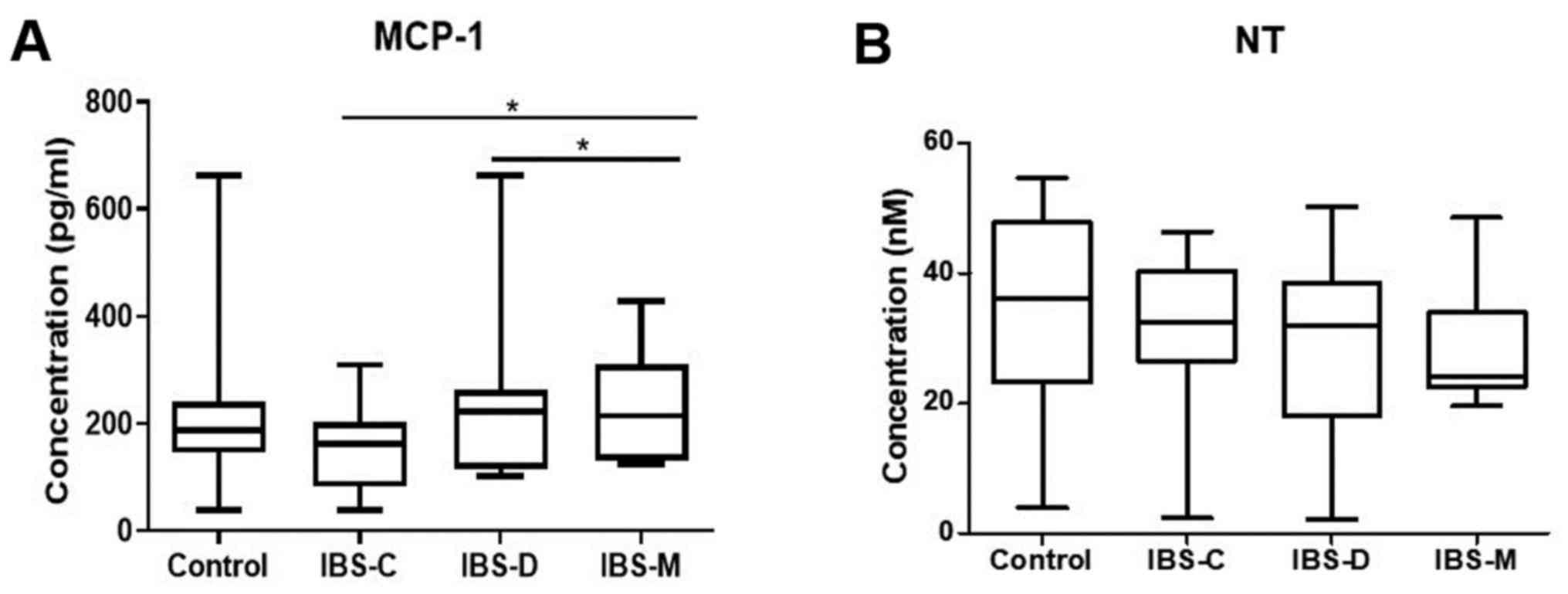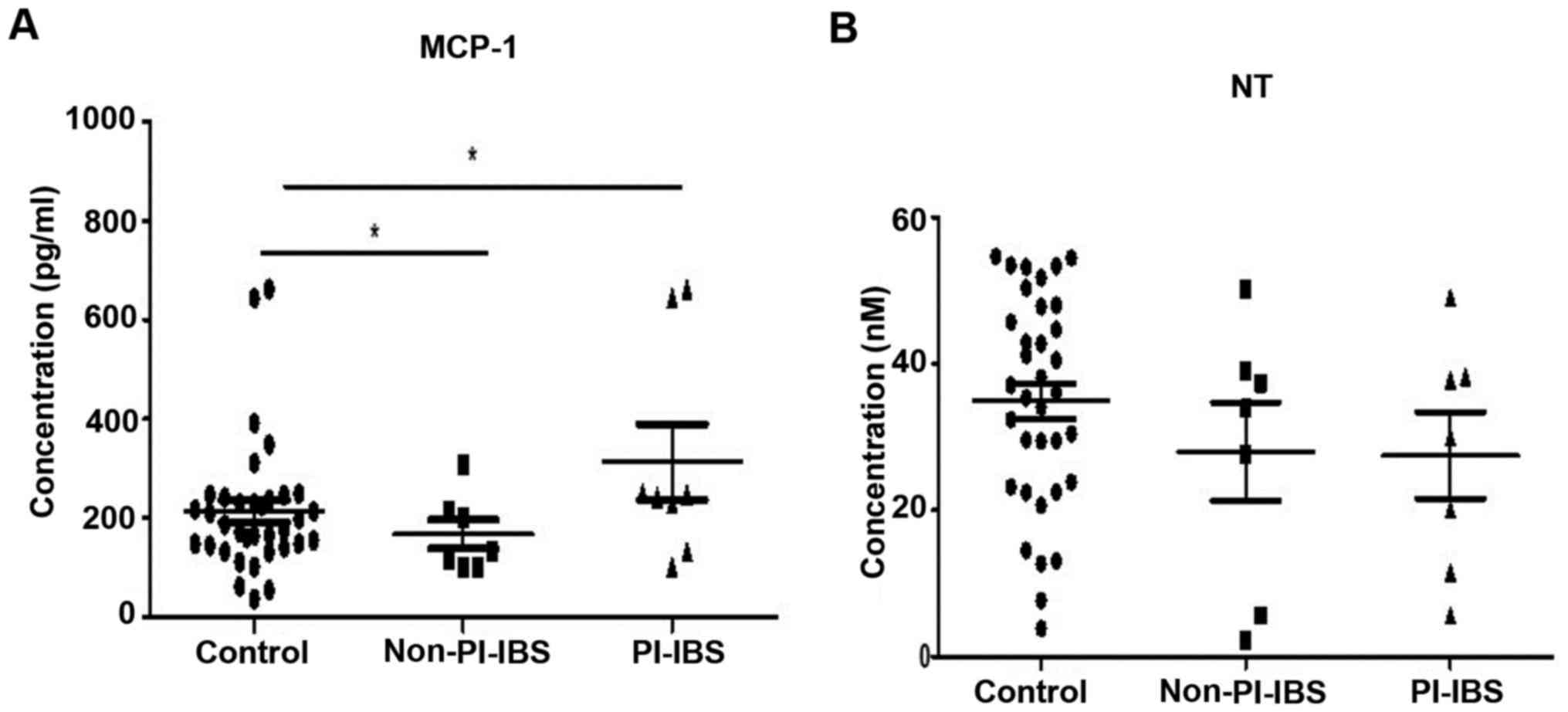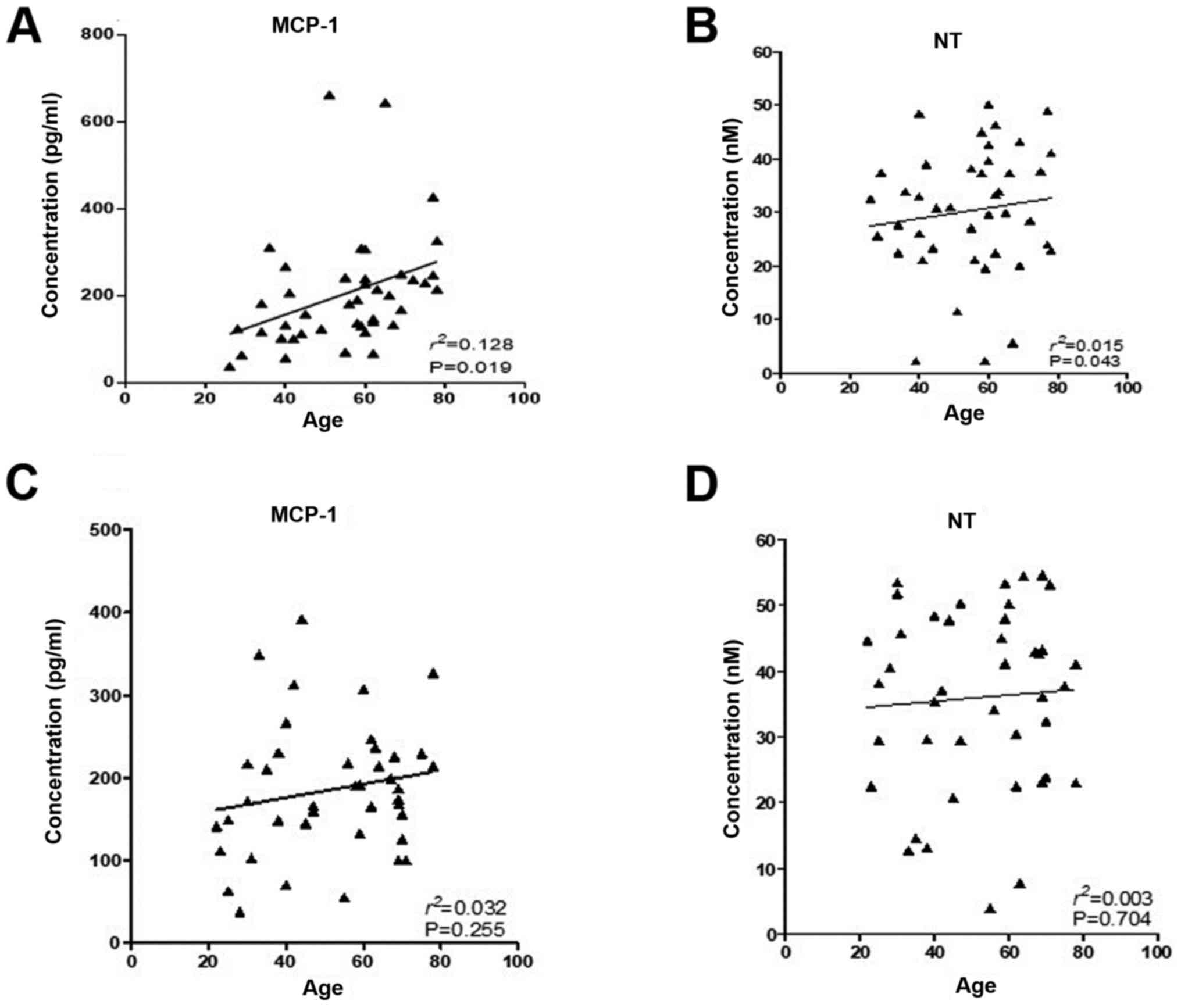|
1
|
Ford AC, Moayyedi P, Lacy BE, Lembo AJ,
Saito YA, Schiller LR, Soffer EE, Spiegel BM and Quigley EM: Task
Force on the Management of Functional Bowel Disorders: American
College of Gastroenterology monograph on the management of
irritable bowel syndrome and chronic idiopathic constipation. Am J
Gastroenterol. 109 (Suppl 1):S2–S26; quiz S27. 2014.PubMed/NCBI View Article : Google Scholar
|
|
2
|
Longstreth GF: Definition and
classification of irritable bowel syndrome: Current consensus and
controversies. Gastroenterol Clin North Am. 34:173–187.
2005.PubMed/NCBI View Article : Google Scholar
|
|
3
|
Longstreth GF, Thompson WG, Chey WD,
Houghton LA, Mearin F and Spiller RC: Functional bowel disorders.
Gastroenterology. 130:1480–1491. 2006.PubMed/NCBI View Article : Google Scholar
|
|
4
|
Gralnek IM, Hays RD, Kilbourne A, Naliboff
B and Mayer EA: The impact of irritable bowel syndrome on
health-related quality of life. Gastroenterology. 119:654–660.
2000.PubMed/NCBI View Article : Google Scholar
|
|
5
|
Drossman DA: Review article: An integrated
approach to the irritable bowel syndrome. Aliment Pharmacol Ther.
13 (Suppl 2):3–14. 1999.PubMed/NCBI View Article : Google Scholar
|
|
6
|
Chaudhary NA and Truelove SC: The
irritable colon syndrome. A study of the clinical features,
predisposing causes, and prognosis in 130 cases. Q J Med.
31:307–322. 1962.PubMed/NCBI
|
|
7
|
McKendrick MW: Post Salmonella
irritable bowel syndrome - 5 year review. J Infect. 32:170–171.
1996.PubMed/NCBI View Article : Google Scholar
|
|
8
|
David LE, Surdea-Blaga T and Dumitrascu
DL: Semiquantitative fecal calprotectin test in postinfectious and
non-postinfectious irritable bowel syndrome: cross-sectional study.
Sao Paulo Med J. 133:343–349. 2015.PubMed/NCBI View Article : Google Scholar
|
|
9
|
Spiller RC, Jenkins D, Thornley JP, Hebden
JM, Wright T, Skinner M and Neal KR: Increased rectal mucosal
enteroendocrine cells, T lymphocytes, and increased gut
permeability following acute Campylobacter enteritis and in
post-dysenteric irritable bowel syndrome. Gut. 47:804–811.
2000.PubMed/NCBI View Article : Google Scholar
|
|
10
|
Bashashati M, Moossavi S, Cremon C,
Barbaro MR, Moraveji S, Talmon G, Rezaei N, Hughes PA, Bian ZX,
Choi CH, et al: Colonic immune cells in irritable bowel syndrome: A
systematic review and meta-analysis. Neurogastroenterol Motil.
30(30)2018.PubMed/NCBI View Article : Google Scholar
|
|
11
|
Camilleri M: Peripheral mechanisms in
irritable bowel syndrome. N Engl J Med. 367:1626–1635.
2012.PubMed/NCBI View Article : Google Scholar
|
|
12
|
Jeffery IB, O’Toole PW, Öhman L, Claesson
MJ, Deane J, Quigley EM and Simrén M: An irritable bowel syndrome
subtype defined by species-specific alterations in faecal
microbiota. Gut. 61:997–1006. 2012.PubMed/NCBI View Article : Google Scholar
|
|
13
|
Shepherd SJ, Parker FC, Muir JG and Gibson
PR: Dietary triggers of abdominal symptoms in patients with
irritable bowel syndrome: Randomized placebo-controlled evidence.
Clin Gastroenterol Hepatol. 6:765–771. 2008.PubMed/NCBI View Article : Google Scholar
|
|
14
|
Lembo AJ, Neri B, Tolley J, Barken D,
Carroll S and Pan H: Use of serum biomarkers in a diagnostic test
for irritable bowel syndrome. Aliment Pharmacol Ther. 29:834–842.
2009.PubMed/NCBI View Article : Google Scholar
|
|
15
|
Snape WJ Jr, Carlson GM, Matarazzo SA and
Cohen S: Evidence that abnormal myoelectrical activity produces
colonic motor dysfunction in the irritable bowel syndrome.
Gastroenterology. 72:383–387. 1977.PubMed/NCBI
|
|
16
|
Stasi C, Rosselli M, Bellini M, Laffi G
and Milani S: Altered neuro-endocrine-immune pathways in the
irritable bowel syndrome: The top-down and the bottom-up model. J
Gastroenterol. 47:1177–1185. 2012.PubMed/NCBI View Article : Google Scholar
|
|
17
|
Yoshimura T, Robinson EA, Tanaka S,
Appella E and Leonard EJ: Purification and amino acid analysis of
two human monocyte chemoattractants produced by
phytohemagglutinin-stimulated human blood mononuclear leukocytes. J
Immunol. 142:1956–1962. 1989.PubMed/NCBI
|
|
18
|
Yoshimura T, Yuhki N, Moore SK, Appella E,
Lerman MI and Leonard EJ: Human monocyte chemoattractant protein-1
(MCP-1). Full-length cDNA cloning, expression in mitogen-stimulated
blood mononuclear leukocytes, and sequence similarity to mouse
competence gene JE. FEBS Lett. 244:487–493. 1989.PubMed/NCBI View Article : Google Scholar
|
|
19
|
Goede V, Brogelli L, Ziche M and Augustin
HG: Induction of inflammatory angiogenesis by monocyte
chemoattractant protein-1. Int J Cancer. 82:765–770.
1999.PubMed/NCBI View Article : Google Scholar
|
|
20
|
Darkoh C, Comer L, Zewdie G, Harold S,
Snyder N and Dupont HL: Chemotactic chemokines are important in the
pathogenesis of irritable bowel syndrome. PLoS One.
9(e93144)2014.PubMed/NCBI View Article : Google Scholar
|
|
21
|
Iyonaga K, Takeya M, Saita N, Sakamoto O,
Yoshimura T, Ando M and Takahashi K: Monocyte chemoattractant
protein-1 in idiopathic pulmonary fibrosis and other interstitial
lung diseases. Hum Pathol. 25:455–463. 1994.PubMed/NCBI View Article : Google Scholar
|
|
22
|
Gerrity RG, Naito HK, Richardson M and
Schwartz CJ: Dietary induced atherogenesis in swine. Morphology of
the intima in prelesion stages. Am J Pathol. 95:775–792.
1979.PubMed/NCBI
|
|
23
|
Oran M, Tulubas F, Mete R, Aydin M,
Sarikaya HG and Gurel A: Evaluation of paraoxonase and arylesterase
activities in patients with irritable bowel syndrome. J Pak Med
Assoc. 64:820–822. 2014.PubMed/NCBI
|
|
24
|
Mete R, Tulubas F, Oran M, Yılmaz A, Avci
BA, Yildiz K, Turan CB and Gurel A: The role of oxidants and
reactive nitrogen species in irritable bowel syndrome: A potential
etiological explanation. Med Sci Monit. 19:762–766. 2013.PubMed/NCBI View Article : Google Scholar
|
|
25
|
Stermer E, Lubezky A, Potasman I, Paster E
and Lavy A: Is traveler’s diarrhea a significant risk factor for
the development of irritable bowel syndrome?A prospective study.
Clin Infect Dis. 43:898–901. 2006.PubMed/NCBI View
Article : Google Scholar
|
|
26
|
Sood R, Gracie DJ, Law GR and Ford AC:
Systematic review with meta-analysis: The accuracy of diagnosing
irritable bowel syndrome with symptoms, biomarkers and/or
psychological markers. Aliment Pharmacol Ther. 42:491–503.
2015.PubMed/NCBI View Article : Google Scholar
|
|
27
|
Chira A and Dumitrascu DL: Serum
biomarkers for irritable bowel syndrome. Clujul Med. 88:258–264.
2015.PubMed/NCBI View
Article : Google Scholar
|
|
28
|
Tülübaş F, Oran M, Mete R, Turan F, Yilmaz
A, Yildiz ZD and Gürel A: Investigation of serum macrophage
migration inhibitor factor and monocyte chemotactic protein-1
levels in irritable bowel syndrome. Turk J Med Sci. 44:967–971.
2014.PubMed/NCBI View Article : Google Scholar
|
|
29
|
Hashimoto S, Nakayama T, Gon Y, Hata N,
Koura T, Maruoka S, Matsumoto K, Hayashi S, Abe Y and Horie T:
Correlation of plasma monocyte chemoattractant protein-1 (MCP-1)
and monocyte inflammatory protein-1alpha (MIP-1alpha) levels with
disease activity and clinical course of sarcoidosis. Clin Exp
Immunol. 111:604–610. 1998.PubMed/NCBI View Article : Google Scholar
|
|
30
|
Arakelyan A, Petrkova J, Hermanova Z,
Boyajyan A, Lukl J and Petrek M: Serum levels of the MCP-1
chemokine in patients with ischemic stroke and myocardial
infarction. Mediators Inflamm. 2005:175–179. 2005.PubMed/NCBI View Article : Google Scholar
|
|
31
|
Inadera H, Egashira K, Takemoto M, Ouchi Y
and Matsushima K: Increase in circulating levels of monocyte
chemoattractant protein-1 with aging. J Interferon Cytokine Res.
19:1179–1182. 1999.PubMed/NCBI View Article : Google Scholar
|
|
32
|
Chen S, Deng C, Hu C, Li J, Wen X, Wu Z
and Li Y, Zhang F and Li Y: Association of MCP-1-2518A/G
polymorphism with susceptibility to autoimmune diseases: A
meta-analysis. Clin Rheumatol. 35:1169–1179. 2016.PubMed/NCBI View Article : Google Scholar
|
|
33
|
Arakelyan A, Zakharyan R, Hambardzumyan M,
Petrkova J, Olsson MC, Petrek M and Boyajyan A: Functional genetic
polymorphisms of monocyte chemoattractant protein 1 and C-C
chemokine receptor type 2 in ischemic stroke. J Interferon Cytokine
Res. 34:100–105. 2014.PubMed/NCBI View Article : Google Scholar
|
|
34
|
Sadik R, Björnsson E and Simrén M: The
relationship between symptoms, body mass index, gastrointestinal
transit and stool frequency in patients with irritable bowel
syndrome. Eur J Gastroenterol Hepatol. 22:102–108. 2010.PubMed/NCBI View Article : Google Scholar
|
|
35
|
Carr D and Friedman MA: Is obesity
stigmatizing? Body weight, perceived discrimination, and
psychological well-being in the United States. J Health Soc Behav.
46:244–259. 2005.PubMed/NCBI View Article : Google Scholar
|
|
36
|
Maes M: Inflammatory and oxidative and
nitrosative stress pathways underpinning chronic fatigue,
somatization and psychosomatic symptoms. Curr Opin Psychiatry.
22:75–83. 2009.PubMed/NCBI View Article : Google Scholar
|
|
37
|
Parks DA, Bulkley GB and Granger DN: Role
of oxygen-derived free radicals in digestive tract diseases.
Surgery. 94:415–422. 1983.PubMed/NCBI
|
|
38
|
Yu Z, Kastenmüller G, He Y, Belcredi P,
Möller G, Prehn C, Mendes J, Wahl S, Roemisch-Margl W, Ceglarek U,
et al: Differences between human plasma and serum metabolite
profiles. PLoS One. 6(e21230)2011.PubMed/NCBI View Article : Google Scholar
|
|
39
|
Zhao Z, Zhou H, Peng Y, Qiu CH, Sun QY,
Wang F and Xie HN: Expression and significance of plasma 3-NT and
ox-LDL in patients with Alzheimer’s disease. Genet Mol Res.
13:8428–8435. 2014.PubMed/NCBI View Article : Google Scholar
|
|
40
|
Sartipy P and Loskutoff DJ: Monocyte
chemoattractant protein 1 in obesity and insulin resistance. Proc
Natl Acad Sci USA. 100:7265–7270. 2003.PubMed/NCBI View Article : Google Scholar
|

















